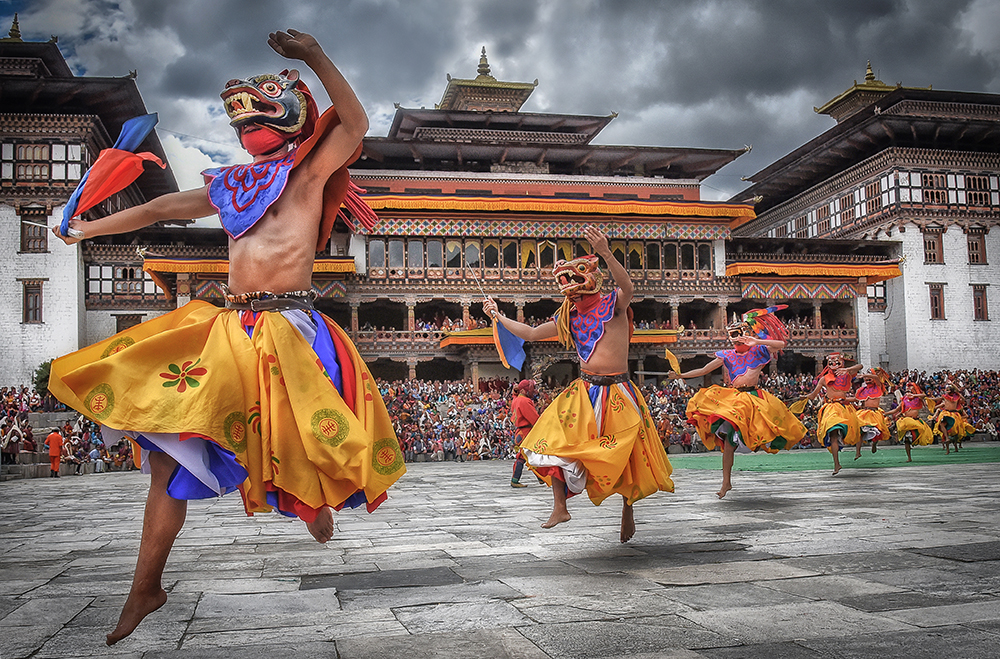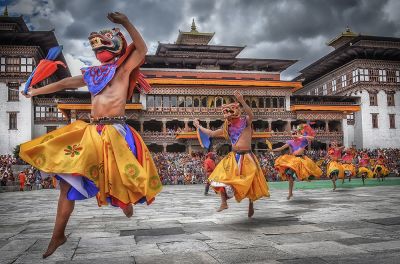

Witness the mesmerizing Cham dance performances, a pivotal element of the Thimphu Tshechu festival. Cham dances are a form of ritual dance that depict tales of valor, compassion, and the triumph of good over evil. Dancers, adorned in richly brocaded costumes and elaborate masks representing various deities, demons, and animals, perform to the accompaniment of traditional Bhutanese music. The dance movements are slow and methodical, corresponding with the rhythmic beats and tunes, which makes watching them a hypnotic experience. Each dance conveys its own story and carries a spiritual significance, believed to confer blessings upon the spectators and also to cleanse them of their sins.
The Thongdroel is a giant thangka (religious Buddhist painting) that is unfurled before dawn on the final day of the Thimphu Tshechu. It represents a large image of Guru Rinpoche (Padmasambhava), surrounded by holy figures, and is believed to cleanse onlookers of their sins. Bhutanese people from all over the country gather to witness this sacred event. The moment the Thongdroel is displayed, an aura of reverence envelops the crowd, and people rush to offer prayers. You won't want to miss the chance to be blessed by the sight of the Thongdroel, as it is an incredibly auspicious and rare opportunity in Bhutanese culture.
Participate in a traditional mask-making workshop, where you'll be introduced to the artistry behind the masks used during the Cham dances. These masks are integral to Bhutanese festivals and are created with intricate designs. The workshop, usually conducted by a local artisan, includes an educational segment explaining the significance of various masks, followed by a hands-on session, where visitors can try their hand at crafting a basic mask. It's not just a craft session; it's a cultural immersion that allows participants to connect with Bhutanese heritage and arts.
Enjoy the excitement of a traditional Bhutanese archery competition. Archery is the national sport of Bhutan and an important feature of the Tshechu festivities. Teams clad in traditional attire showcase their skills with a bow and arrow, competing at impressive distances. The event is filled with good-natured taunting and singing, as competitors aim to hit small wooden targets. It's a lively social occasion and spectators are welcome to cheer on the teams. As a visitor, you'll experience the joy and camaraderie that are emblematic of Bhutanese festivals, and you may even have a chance to try your hand at Bhutanese archery!
Explore the Tshechu fairground stalls that pop up around the festival. The lively marketplace features vendors selling a variety of Bhutanese handicrafts, textiles, and religious items. You can find colorful hand-woven garments, traditional boots, prayer wheels, and intricate jewelry. Food stalls serve local delicacies, giving visitors a taste of Bhutanese cuisine. It's an excellent place to purchase souvenirs, interact with the locals, and observe traditional Bhutanese trade and negotiation practices. Walking among the stalls, you'll also enjoy casual performances and snippets of folklore from storytellers, adding flavor to your market experience.
Encounter the Atsaras, or clowns, who contribute a comedic element to the seriousness of the religious proceedings. Adorned with red masks and often found teasing the crowd, Atsaras play a critical role in Tshechu festivals. They keep the atmosphere light, engage with children, and often give out blessings in their unique way. The Atsaras also serve a symbolic purpose by representing acarayas, religious teachers who are known for their humor and wit. These jesters are more than mere entertainers; they hold the power to mock social issues, making them a cultural phenomenon essential to the festival.
Attend engrossing monastic debates, an intellectual component of the Thimphu Tshechu. These debates feature monks and scholars engaging in intense theological exchanges on Buddhist philosophy. They employ a distinct style of debate that includes clapping and dramatic gestures to emphasize points and counterpoints. This practice helps in the sharpening of their understanding and also serves as a learning tool for the public. It's not only an educational experience for visitors but also an insight into the spiritual zeal that permeates Bhutanese culture.
Join in cultural dance lessons offered during the festival. These lessons provide an opportunity to learn traditional Bhutanese dances firsthand from local dancers. Engaging in dance not only allows you to immerse yourself in the local customs and perform alongside residents but also to appreciate the complexity and grace of Bhutanese performance arts. This experience offers a delightful way to actively participate in the celebration and understand the storytelling essence of Bhutanese culture.
Embrace Bhutanese culture by dressing up in traditional Bhutanese attire—Gho for men and Kira for women—and participating in a photo session against the backdrop of the Thimphu Tshechu festivities. The textiles and patterns of the clothing are stunning, and the experience offers you a unique memento of your time at the festival. Locals are delighted to help visitors wear the attire correctly and to explain the symbolism and occasion for different styles. A professional photographer might be available to capture the moment, or you could simply ask a fellow spectator for a snapshot.
Partake in the spiritual heart of the festival by receiving blessings and joining in prayer ceremonies led by revered lamas and monks. As sacred chants and prayers resound throughout the courtyards of the Tashichho Dzong, the primary location of the ceremony, the air fills with an aura of spirituality. These prayer ceremonies are not only an integral part of the Tshechu but also a potent spiritual experience for the faithful and visitors alike. The blessing from a high lama or a revered monk is considered to be highly auspicious and is sought after by both locals and tourists.
